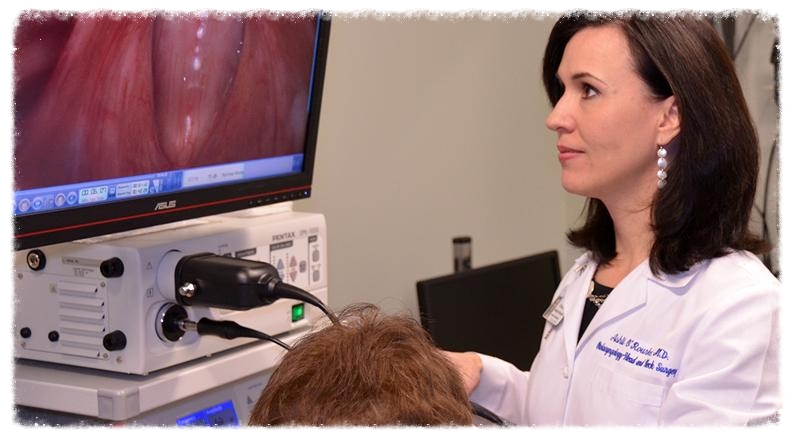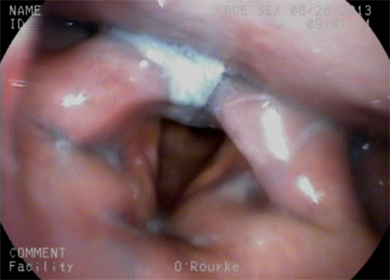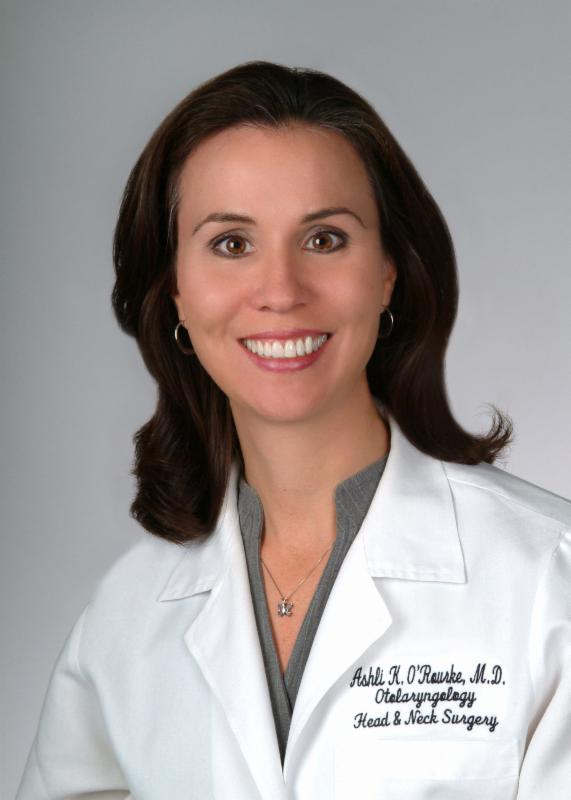May 2014:
Evaluation of Sleep Disordered Breathing in Children
June 2014:
The Link Between CRS and Asthma
July 2014:
Skullbase Defects and CSF Leaks
|
Our E-Update Newsletters are designed to provide brief, practical, clinical updates in areas where we all struggle in managing our patients. To view past issues, please visit our Archives. |
April 2014
Temporal Bone Dissection Course
May 2014
Sinus Masters
Southern States Rhinology Course Charleston Magnolia Conference
July 2014
The Charleston Course: Otolaryngology Literature Update
For program brochure, registration form, and more, please visit
our website.
|
We want to hear from you!
We welcome your feedback on our newsletter articles as well as any ENT questions you may have. If there are topics you are interested in learning more about, please
|
|
|
Happy Spring! In this E-Udate, Ashli K. O'Rourke, M.D. describes why
dysphagia due to established radiation induced fibrosis is difficult to treat and why prevention appears to be the best approach.
More information on Dr. O'Rourke follows the article below and is on our website. We encourage your feedback or questions about the E-Udate articles, your patients, or any other ENT issue at [email protected]. Many thanks for your continued interest and support.
Paul R. Lambert, MD
Professor and Chair
|
|
 | | Ashli K. O'Rourke, M.D. - Assistant Professor, MUSC |
Dysphagia Due to Late Onset Radiation Induced Fibrosis
| |
Radiation induced fibrosis (RIF) is the pathologic replacement of normal tissue with a dense fibrous collagen matrix. This process can result in progressive muscular fibrosis and loss of function.1 Signs of RIF typically begin greater than one year following radiation treatment, and include difficulty in swallowing (dysphagia). Dysphagia due to radiation induced fibrosis (DRIF) places patients at high risk for aspiration, malnutrition, and decreased quality of life.2-4 Since DRIF is difficult to treat, patients often suffer progressive worsening of their symptoms and many require alternative feeding methods.
Mechanism of Radiation Induced Fibrosis
The exact mechanism of late RIF has not been clearly elucidated and likely represents a complex interplay of the many different proposed mechanisms. First, repeated tissue "injury" from fractionated radiation appears to generate abnormal wound healing mechanisms and injure endothelial cells.5 This leads to microvascular destruction and tissue hypoxia. Altered fibroblasts and myofibroblasts have been cultured from late irradiated tissues and these cells exhibit decreased growth, shorter lifespans, and lower superoxide dismutase and catalase (free radical scavengers) activity than those in normal tissue samples.6 In addition, cytokine up-regulation, particularly transforming growth factor beta (TGF-β), occurs in irradiated tissues .5,7-9 TGF- β stimulates collagen production, inhibits extracellular matrix breakdown, and inhibits epithelial cell proliferation. These mechanisms all may play a role in fibrosis development.
Scope of the Problem
Late dysphagia occurs in approximately 10 - 14% of patients with oropharyngeal tumors treated with radiotherapy (RT),11-12 and as many as 83% of patients with pharyngeal carcinoma treated with RT may experience dysphagia.13
Many investigators have examined the dosimetry relationships of specific swallowing structures and predictors for the development of late onset dysphagia.14-22 The most predictive indicators are the mean dosage to the pharyngeal constrictor muscles,17-21,23-25 upper esophagus,23,25 supraglottic larynx,19-21,23 and glottic larynx.17,20-21,23 Most studies show that when greater than 50% of the involved swallowing musculature receives >50 Gy, the risk of developing late onset dysphagia is increased.17-21,23-25 Particularly, patients with >60 Gy dosing to the pharyngeal musculature are at increased risk for silent aspiration,3-4 and dosage to the pharyngeal constrictor muscles >65 Gy and the laryngeal complex >50 Gy is predictive of percutaneous gastrostomy tube (PEG) dependency.26,27
 |
Figure 1: View of larynx during flexible endoscopic evaluation of swallowing study in a patient 9 years after chemoradiation for base of tongue cancer. He presented with progressive dysphagia and exhibited poor pharyngeal muscular contraction, decreased sensation, and aspiration.
|
Treatment of DRIF The emphasis for DRIF has primarily been on prevention because there are few treatments available. Radiation dose sparing techniques, such as 3D conformal radiotherapy or intensity modulated radiotherapy (IMRT), have sought to reduce the incidence of DRIF by lessening radiation to surrounding tissues. Depending on the site of lesion, nodal involvement and target tissue, decreased radiation to structures vital for swallowing function may not be possible. After all, the first principle of treatment is curative intent, and few studies have examined long-term locoregional control following specific IMRT dysphagia avoidance protocols. Prophylactic swallowing exercises have been shown to modestly improve swallowing function when compared to patients who do not follow a pre-treatment exercise program.28,29 It is crucial for patients to begin swallowing exercises prior to treatment and
to continue them well beyond treatment on a daily basis. Unfortunately, the follow-up periods for most of these studies are relatively short and long-term effectiveness remains unknown. It must be noted as well that adherence to preventative exercise programs is surprisingly low, with only 13% of patients found to be fully adherent over a two year period.30 Lastly, the maintenance of oral intake, even if supplemented with alternative nutrition, has been shown to decrease PEG dependence. At one year post RT, these patients have more advanced diets and better weight gain/maintenance than patients completely dependent on tube feedings. 31 Conclusion Dysphagia due to established radiation induced fibrosis is a difficult problem to treat. Until effective medical therapies are available, prevention appears to be the best approach. Patients undergoing radiation therapy for head and neck cancer should be evaluated by a speech pathologist and begin prophylactic swallowing therapy. Patients should also be encouraged to maintain some degree of per oral intake throughout their radiation course. Ashli K. O'Rourke , M.D.
Medical University of South Carolina
|
|
REFERENCES
-
Murphy BA and Gilbert J. Dysphagia in head and neck cancer patients treated with radiation: assessment, sequelae, and rehabilitation.
Seminars in Radiation Oncology 2009; 19:35-42.
- Smith RV, Goldman SY, Beitler JJ, et al. Decreased short- and long-term swallowing problems with altered radiotherapy dosing used in an organ-sparing protocol for advanced pharyngeal carcinoma. Arch Otolaryngol Head Neck Surg 2004; 130:831-6.
- Eisbruch A, Lyden T, Bradford CR, et al. Objective assessment of swallowing dysfunction and aspiration after radiation concurrent with chemotherapy for head-and-neck cancer. Int. J. Radiation Oncology Biol. Phys. 2002; 53(1):23-8.
- Nguyen NP, Moltz CC, Frank C, et al. Dysphagia following chemoradiation for locally advanced head and neck cancer. Annals of Oncology 2004; 15:383-8.
- Denham JW and Hauer-Jensen M. The radiotherapeutic injury - a complex 'wound'. Radiotherapy and Oncology 2002; 63:129-45.
- Delanian S, Martin M, Bravard A, et al. Abnormal phenotype of cultured fibroblasts in human skin with chronic radiotherapy damage. Radiotherapy and Oncology 1997; 47:255-61.
- Wynn TA. Cellular and molecular mechanisms of fibrosis. Journal of Pathology 2008; 214:199-210.
- Mueller CK and Schultze-Mosgau S. Radiation-induced microenvironments - the molecular basis for free flap complications in the pre-irradiated field? Radiotherapy and Oncology 2009; 93:581-5.
- Gallet P, Phulpin B, Merlin J-L, et al. Long-term alterations of cytokines and growth factors expression in irradiated tissues and relation with histological severity scoring. PLoS ONE 2011; 6(12):e29399.
- Caudell JJ, Schaner PE, Meredith RF, et al. Factors associated with long-term dysphagia after definitive radiotherapy for locally advanced head-and-neck cancer. Int. J. Radiation Oncology Biol. Phys. 2009; 73(2):410-5.
- McBride SM, Parambi RJ, Jang JW, et al. Intensity-modulated versus conventional radiation therapy for oropharyngeal carcinoma: long-term dysphagia and tumor control outcomes. Head & Neck 2013; DOI 10.1002/HED.
- Mortensen HR, Jensen K, Aksgl�de K, et al. Late dysphagia after IMRT for head and neck cancer and correlation with dose-volume parameters. Radiotherapy and Oncology 2013; 107:288-94.
- Jensen K, Lambertsen K, and Grau C. Late swallowing dysfunction and dysphagia after radiotherapy for pharynx cancer: frequency, intensity and correlation with dose and volume parameters. Radiotherapy and Oncology 2007; 85:74-82.
- O'Sullivan B and Levin W. Late radiation-related fibrosis: pathogenesis, manifestations, and current management. Seminars in Radiation Oncology 2003; 13(3):274-89.
- Davis AM, Dische S, Gerber L, et al. Measuring postirradiation subcutaneous soft-tissue fibrosis: state-of-the-art and future directions. Seminars in Radiation Oncology 2003; 13(3):203-13.
- Bhide SA, Gulliford S, Kazi R, et al. Correlation between dose to the pharyngeal constrictors and patient quality of life and late dysphagia following chemo-IMRT for head and neck cancer. Radiotherapy and Oncology 2009; 93:539-44.
- Caglar HB, Tishler RB, Othus M, et al. Dose to larynx predicts for swallowing complications after intensity-modulated radiotherapy. Int. J. Radiation Oncology Biol. Phys. 2008; 72(4):1110-8.
- Deantonio L, Masini L, Brambilla M, et al. Dysphagia after definitive radiotheraphy for head and neck cancer. Strahlentherapie und Onkologie 2013; 3:230-2.
- Dirix P, Abbeel S, Vanstraelen B, et al. Dysphagia after chemoradiotherapy for head-and-neck squamous cell carcinoma: dose-effect relationships for the swallowing structures. Int. J. Radiation Oncology Biol. Phys. 2009; 75(2):385-92.
- Eisbruch A, Schwartz M, Rasch C, et al. Dysphagia and aspiration after chemoradiotherapy for head-and-neck cancer: which anatomic structures are affected and can they be spared by IMRT? Int. J. Radiation Oncology Biol. Phys. 2004; 60(5):1425-39.
- Eisbruch A, Levendag PC, Feng FY, et al. Can IMRT or brachytherapy reduce dysphagia associated with chemoradiotherapy of head and neck cancer? The Michigan and Rotterdam experiences. Int. J. Radiation Oncology Biol. Phys. 2007; 69(2):S40-2.
- Schwartz DL, Hutcheson K, Barringer D, et al. Candidate dosimetric predictors of long-term swallowing dysfunction after oropharyngeal intensity-modulated radiotherapy. Int. J. Radiation Oncology Biol. Phys. 2010; 78(5):1356-65.
- Eisbruch A, Kim HM, Feng FY, et al. Chemo-IMRT of oropharyngeal cancer aiming to reduce dysphagia: swallowing organs late complication probabilities and dosimetric correlates. Int. J. Radiation Oncology Biol. Phys. 2011; 81(3):e93-9.
- Feng FY, Kim HM, Lyden TH, et al. Intensity-modulated radiotherapy of head and neck cancer aiming to reduce dysphagia: early dose-effect relationships for the swallowing structures. Int J Radiat Oncol Biol Phys. 2007;68(5):1289-98.
- Feng FY, Kim HM, Lyden TH et al. Intensity-modulated chemoradiotherapy aiming to reduce dysphagia in patients with oropharyngeal cancer: clinical and functional results. J Clin Oncol. 2010: 28: 2732-38.
- Sanguineti G, Gunn GB, Parker BC, et al. Weekly dose-volume parameters of mucosa and constrictor muscles predict the use of percutaneous endoscopic gastrostomy during exclusive intensity-modulated radiotherapy for oropharyngeal cancer. Int. J. Radiation Oncology Biol. Phys. 2011; 79(1):52-9.
- Sanguineti G, Rao N, Gunn B, et al. Predictors of PEG dependence after IMRT � chemotherapy for oropharyngeal cancer. Radiotherapy and Oncology 2013; 107:300-4.
- Duarte VM, Chhetri DK, Liu YF, et al. Swallow preservation exercises during chemoradiation therapy maintains swallow function. Otolaryngology-Head and Neck Surgery 2013; 149:878.
- Kulbersh BD, Rosenthal EL, McGrew BM, et al. Pretreatment, preoperative swallowing exercises may improve dysphagia quality of life. The Laryngoscope 2006; 116:883-6.
- Shinn EH, Basen-Engquist K, Baum G, et al. Adherence to preventive exercises and self-reported swallowing outcomes in post-radiation head and neck cancer patients. Head and Neck 2013; 35: 1707-1712.
- Langmore S, Krisciunas GP, Miloro KV, Evans SR, Cheng DM. Does PEG use cause dysphagia in head and neck cancer patients? Dysphagia. 2012;27(2):251-9.
|
About Dr. O'Rourke...

Ashli K. O'Rourke , M.D.
Assistant Professor
M.D.: Medical College of Georgia Residency: University of Virginia
Health System
Fellowship: Medical College of Georgia
Special interest:
Swallowing disorders, Dysphagia, Early laryngeal cancer, Laryngopharyngeal reflux disease, Airway stenosis and reconstruction, Medical and surgical treatment of
voice disorders
|
|
|
|
|